The ultimate guide to traveling with chronic pain
Signing up for credit cards through partner links earns us a commission. Terms apply to the offers listed on this page. Here’s our full advertising policy: How we make money.
Update: One or more card offers in this post are no longer available. Check our Hot Deals for the latest offers.
INSIDER SECRET: Booking a seat in business or first class can go a long way in alleviating any pain or discomfort during your flight — and you don’t have to spend a fortune if you redeem your miles and points.
If you live with chronic pain, dausingily tasks like cooking, cleaning, and showering can be difficult and exhausting. And often that chronic pain — whether it be arthritis, fybromyalgia, Lyme disease, jo
int pain or other ailments — is invisible to those on the outside, and can flare without warning.
While that means traveling requires extra planning and precautions, it doesn’t mean you shouldn’t see more of the world.
To help you plan ahead, we’ve put together a guide on how to travel if you’re living with chronic pain. We’ll cover what to pack, questions to ask, and much more. That way you can take advantage of the best airline credit cards to earn miles and points, and take amazing trips for pennies on the dollar.

Table of Contents:
- Before the Trip: How to Pack for Travel When You Suffer from Chronic Pain
- Air Travel with Chronic Pain
- Ground Travel with Chronic Pain
- Traveling by Train with Chronic Pain
- Traveling on a Ship with Chronic Pain
- Finding Lodging When Traveling with Chronic Pain
- Other Tips
Before the trip: How to pack for travel when you suffer from chronic pain
Give yourself extra time to pack. This will help reduce stress, because you’ll know you have everything you need to manage your condition.
Fill your prescriptions well before your trip, and have enough with you for the duration of your time away. Pack them in your carry-on bag (never in your checked luggage) and put it within quick reach. Consider taking a small bag to carry with you throughout your entire journey, so they’ll always be close at hand.
Pack other helpful items like a heating pack, a neck pillow for long flights or train rides and a good pair of shoes if you plan to do a lot of walking or sightseeing on your trip. Bring along a note from your doctor explaining your condition and a list of the medications you’re taking, in case you need to show it for medical assistance or to get through the TSA checkpoint at the airport.

Another option is to ship your luggage to your destination so you don’t have to hassle with lugging your stuff as you travel. Keep a bag with your essentials, and let the rest be there waiting for your arrival.
Check out companies like Luggage Free, LugLess and Send My Bag to handle delivery directly to your hotel or other location. It’s one more thing to do before you travel, but can make your experience easier and more convenient.
Air travel with chronic pain
If you suffer from chronic pain, any flight can bring dread. Cramped seats with a limited recline and ever-shrinking lavatory spaces can present difficulties, whether your flight is a quick hop or several hours.
If the idea of sitting in coach is daunting, consider using the best airline credit cards to rack up miles and points you can use toward a bigger seat in business or first class.
For example, with the Chase Sapphire Preferred® Card, you can earn 60,000 bonus points after you spend $4,000 on purchases in the first three months from account opening. The Chase Ultimate Rewards portal is an easy way to redeem your points for travel. Or you can transfer your points directly to airline partners at a 1:1 ratio, including British Airways, United Airlines, and Southwest.
The bonus points you earn can be worth $750 in travel if you follow our tricks to get the most from them. Here’s our full review of the Chase Sapphire Preferred. It’s the #1 card we recommend to those starting out with miles and points.
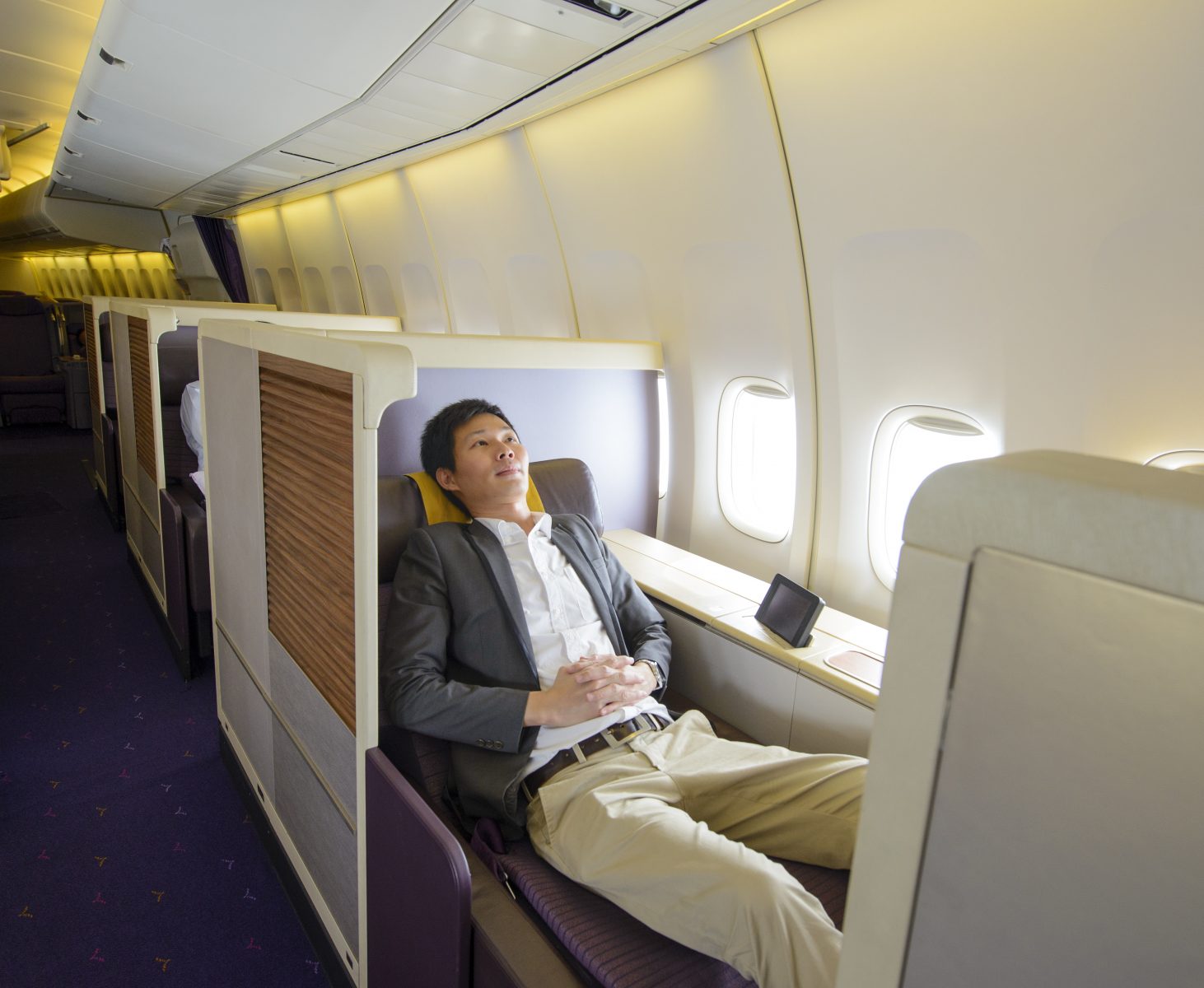
Try to book your airline travel as early as possible so you can select an aisle seat, which will make it easier for you to get up throughout the flight to stretch your legs and give you more breathing room when seated.
Avoid booking seats in the back of the plane. There are two reasons for this: First, the back row of seats on a plane usually do not give you room to recline. Second, you’ll feel turbulence more, which can be painful if you have chronic pain. If you feel an aisle or forward seat is a medical necessity, and you were not able to secure one ahead of time, get a note from your doctor and present it to the gate agent before you board. They can be your ally and help shuffle seats to make you more comfortable.
Arriving at the airport
Get to the airport early to give yourself plenty of time to check bags, go through security and find your gate — especially if you need to arrange wheelchair access.
Tips for going through security
Consider getting TSA PreCheck to make going through security less stressful. There are many travel rewards credit cards that come with a statement credit for TSA PreCheck.
TSA PreCheck can get you through security, and to your gate, much faster. (Photo by Harlan Vaughn/Million Mile Secrets)If you have chronic pain or nerve disorders, you may dread going through security because of the chance you’ll have a pat-down. Even a small touch can be painful for some chronic pain sufferers.
If you are selected for additional screening, let a TSA agent know they need to be gentle during the pat down. TSA has the option to take you to a private room with seats, if it makes you more comfortable.
Remember, normal liquid restrictions don’t apply to required medications. If you need liquid medicine during your trip, be sure to let an agent know so they can screen your other liquids separately.
Waiting for your flight
Once you’re through security, get to your gate early. If you’re able to do so, move around to keep your circulation up, because when you get on the plane, you may be sitting for a while.
If you have plenty of time, you might even consider a stop at an airport lounge, where you can have a beverage and snack before your flight. You may already have free lounge access with certain credit cards, like The Business Platinum Card® from American Express, which gives you entry to Delta Sky Club (if you’re flying Delta that day), Priority Pass, Airspace and American Express Centurion Lounges. Other cards to consider include Chase Sapphire Reserve® and Citi Prestige.
If you have a longer layover, another option is to take advantage of an airport spa, like XpresSpa, which has locations in over 20+ airports. A back massage will help ease the stress of traveling.
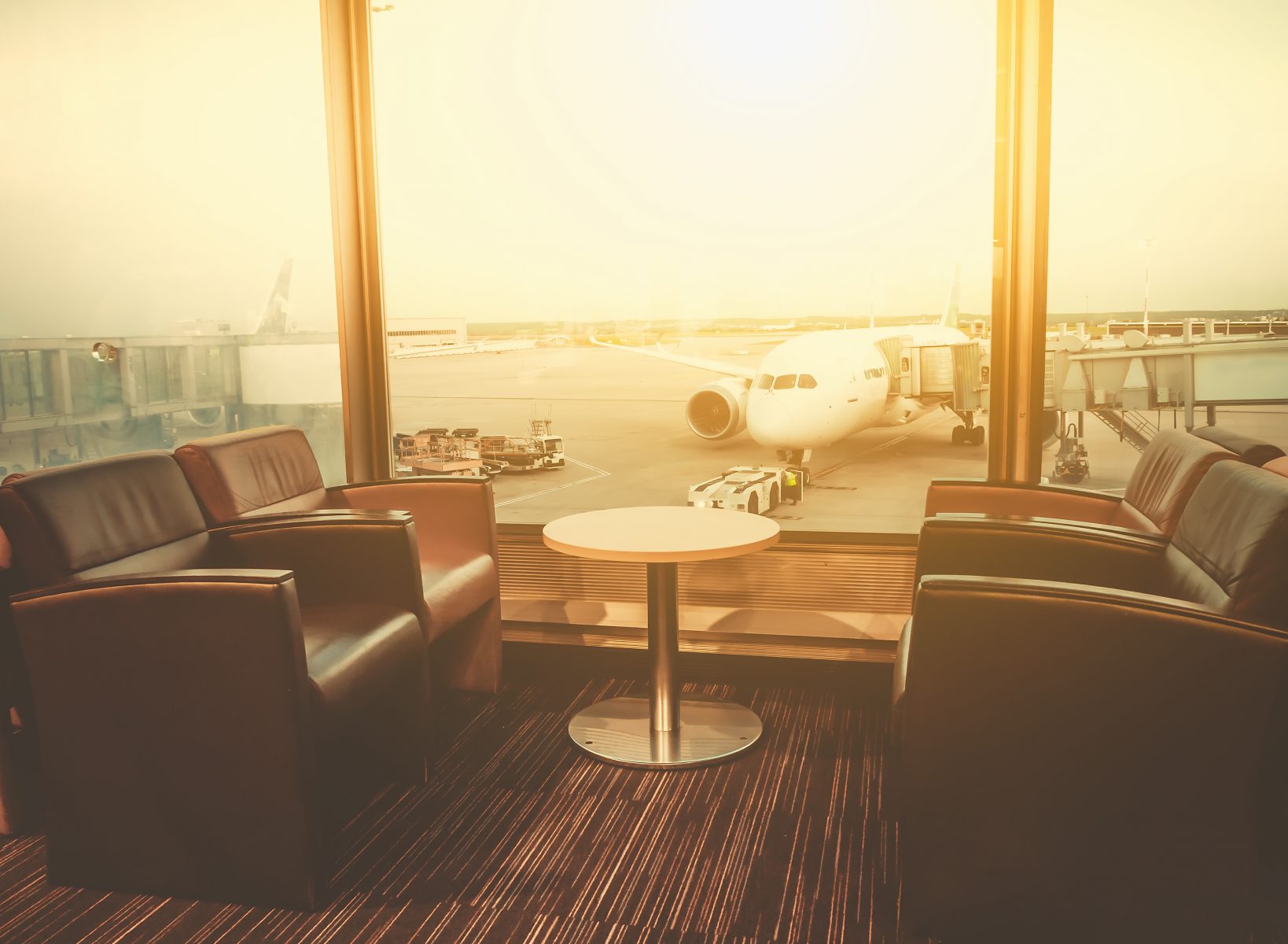
Don’t want to spend money at a spa? Some airports that have yoga and meditation rooms, including:
- Burlington International Airport (BTV)
- Chicago O’Hare International Airport (ORD)
- Chicago Midway Airport (MDW)
- Dallas-Fort Worth International Airport (DFW)
- Helsinki Airport (HEL)
- Hong Kong International Airport (HKG)
- London Gatwick Airport (LGW)
- London Heathrow (LHR)
- Miami International Airport (MIA)
- New York (JFK)
- San Francisco International Airport (SFO)
When it’s close to boarding time, make sure you’re near the gate. If you feel you need assistance, like a different seat or more time to board, speak to the gate agent.
Wheelchair help at the airport
Wheelchair assistance is available if you need it. The Air Carrier Access Act (ACA) requires airlines to let you use your wheelchair, mobility scooter or walker as far as the aircraft boarding door, where they will then gate check it and return it to you upon arrival. The airline will arrange an aisle seat for you, too.
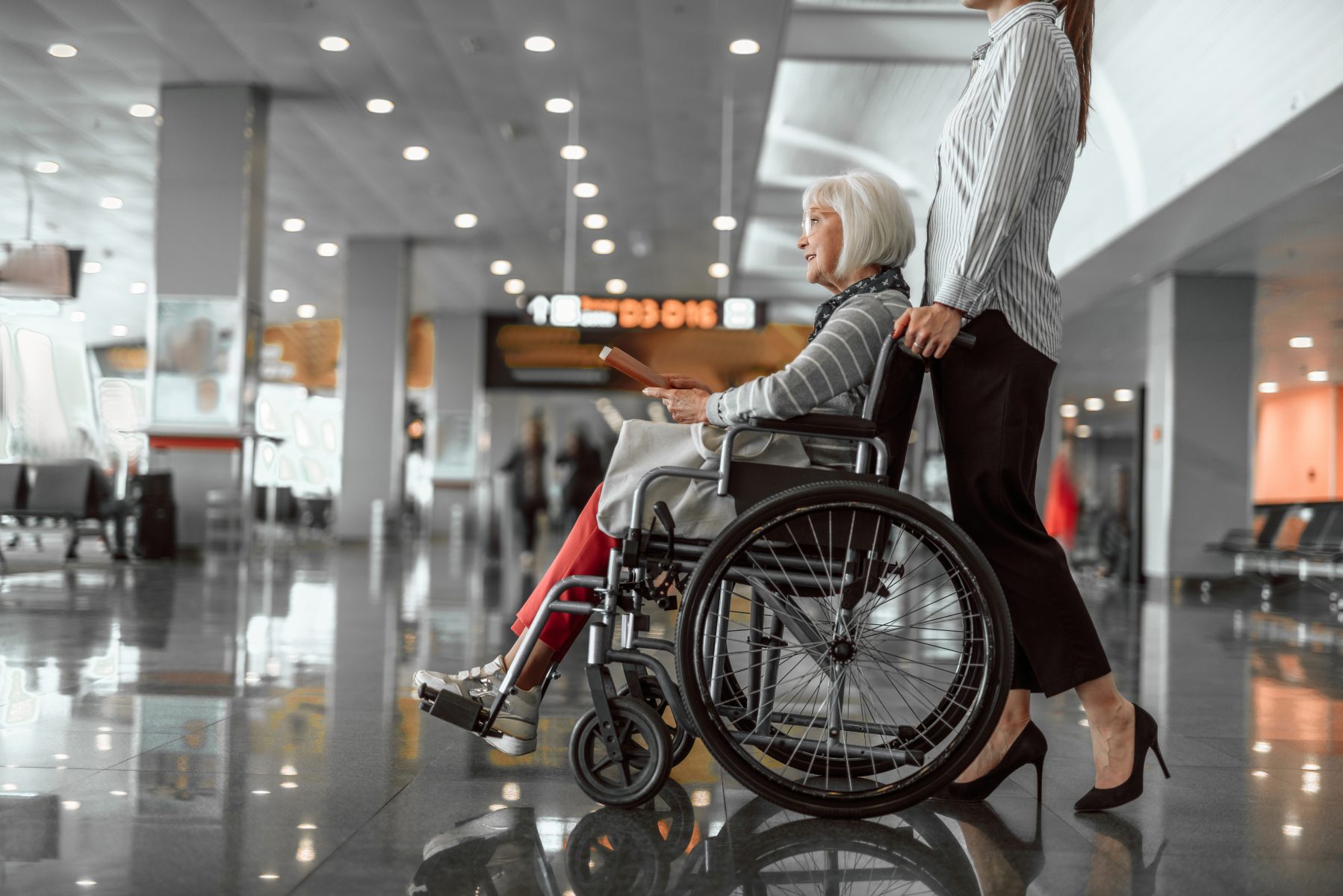
If you feel like you need it, call the airline in advance to arrange for a wheelchair to help you through the airport. Try to call for this accommodation at least 48 hours before departure.
Here’s wheelchair and accessibility information for the top 15 airports in the US:
| Airport | Accessible Restrooms | Handicap Parking | Wheelchair Service |
|---|---|---|---|
| Charlotte Douglas International Airport (CLT) | Yes, all restrooms are accessible. Family restrooms are located near gates A6, B4, C7, D5, E5, E15 and Arrivals/Baggage area, Zones B and E. | Handicap parking is available in all CLT lots and accessible shuttles run continuously. If assistance is needed, please call 704-359-4038. If you wish to park your vehicle and escort a disabled passenger into the terminal, it is recommended that you park in the Hourly Deck in front of the terminal. The first hour of parking in the Hourly Deck is free. | Contact your airline prior to travel for wheelchairs, passenger loading lifts, personal assistance throughout a connection or escort assistance for minors. |
| Dallas/Fort Worth International Airport (DFW) | All restrooms located throughout the terminals are fully accessible to travelers with disabilities. Unisex toilet rooms equipped for the disabled are also available throughout the terminals and are located adjacent to the accessible men’s and women’s toilet rooms. | Disabled permit parking is available in signed areas of all parking lots and garages. In the Terminal garages, disabled parking is on both the upper arrival and lower departures roadways. One-hour areas may be utilized for long-term parking as long as the vehicle displays a disabled parking tag or license plate. Due to TSA and height restrictions garages at some terminals are not van accessible. Express and Remote lots are served by wheelchair accessible shuttle buses. DFW Airport Valet parking is also available at all terminals. | Wheelchair service is offered through your air carrier upon request. To ensure availability and timely service, it’s recommended that reservations be made in advance. However, wheelchair assistance may be requested at airline ticket counters. |
| Denver International Airport (DEN) | Large, private Unisex/Family restrooms are located throughout Jeppesen Terminal and on each concourse. All restrooms are handicap accessible. | Denver International Airport provides accessible parking spaces at all airport-owned parking facilities. In the East and West parking garages, these spaces are located next to entry doors into Jeppesen Terminal, on garage Levels 1, 2, 4 and 5 (no accessible parking is available on Level 3). If using outlying parking options, such as economy or shuttle lots, accessible spaces are located near the pickup/dropoff shelters in the Economy West and Economy East parking lots, and at the Pikes Peak and Mt. Elbert Shuttle lots. All vans and buses serving these lots are lift-equipped. Wheelchair or electric cart service is available from your airline. For more information call (303) 342-4650. | Your airline can provide you with wheelchair or electric cart service Request a wheelchair from the airline in advance or at the ticket counter |
| George Bush Intercontinental Airport (IAH) | Airport restrooms are wheelchair accessible, and family restrooms that accommodate companion care are located throughout the airport. | Accessible parking spaces are located on all levels at all airport-owned parking garages as well as at ecopark and ecopark2. Shuttles from ecopark locations to the airport that accommodate wheelchairs are available. Customers may call 1-281-233-1786 to inquire about accessible parking and shuttle service. | Wheelchair service is provided by airlines for passengers and should be requested when booking travel. |
| Hartsfield-Jackson Atlanta International Airport (ATL) | All restroom facilities are fully equipped for wheelchair access. Four sets of “Men/Women” restrooms are located on each concourse. One set is located at either end, and two sets are centrally located on each concourse. Two sets are in the Airport’s Domestic Terminal atrium, including one set in the arrival’s lobby. Additional restrooms are located at the International Terminal, with a set on both the departure and arrival levels. Unisex family restrooms for those traveling with an attendant are located throughout the Airport: Domestic terminal arrival’s lobby (2) T2, T4, T8 and T12 A6 and A27 B9, B23 and B27 C15, C18 and C37 D4 and D32 F4, F6, F9, F12 Concourse F mezzanine level, departure level and arrival level An adult changing table is located in the family bathroom at Concourse F departure level near French Meadow Cafe. | Parking for passengers with disabilities is available in all Airport parking areas. Once you enter the parking lot, just follow the signs to the designated parking spaces, which are closest to the Airport’s terminals. Passengers with disabilities are encouraged to use the Airport “Park-Ride” facility, which offers convenient service to the domestic terminal. A free, wheelchair-accessible shuttle bus will pick up passengers at their vehicle and take them to curbside check-in. Vans taller than 8 feet should park in “Park-Ride” lots. Upon returning to Hartsfield-Jackson, “Park-Ride” customers are picked up at the ground transportation area. “Park-Ride” parking rates are $1 per hour and $9 per day. For additional information, contact ABM-Lanier-Hunt 24 hours a day at (404) 530-6725. | Airline representatives are available to provide wheelchair assistance. To reserve a wheelchair, contact the airline directly before your scheduled flight. Passengers with limited English proficiency should contact their airline for language assistance. Due to partial closures on the North Terminal roadways, passengers who need wheelchair assistance for drop-off between 9 p.m. and 5 a.m. should contact their airline’s wheelchair company at least five minutes before arriving at the Airport. Prime Flight (Air Canada, Alaska, American, Contour, Spirit and Turkish) – 404-530-7049 Prospect (JetBlue, Southwest and United) – 404-209-0503 |
| John F. Kennedy International Airport (JFK) | Each terminal has at least one wheelchair accessible restroom. If you need assistance locating one, just ask at the information booth located on the Arrivals Level in any of the terminals. | The terminals and parking lots at JFK are divided into five areas, each specified by a separate color. For your convenience, the parking lots nearest the terminal entrances have a limited number of spaces for travelers with disabilities. To park in the spaces, official license plates issued by a municipality or state of residence must be prominently displayed. Parking fees for these vehicles are equal to the lowest rate available at the airport. | Contact your airline prior to travel for wheelchairs. If you’re traveling with a motorized wheelchair, please ask the airline when you purchase the ticket about their policies regarding battery-operated wheelchairs. |
| Los Angeles International Airport (LAX) | Each terminal has at least one wheelchair accessible restroom. | All parking facilities have designated handicap parking stalls. | Requesting a Wheelchair To Request wheelchair service, it is recommended you contact your airline 72 hours in advance. Wheelchair service is provide free of charge by your airline. Tipping is not required for wheelchair service. Most individuals requesting wheelchair assistance are transported via wheelchair from ticketing to their aircraft. Airlines are required to provide curbside wheelchair service when requested. On your return flight, you should remind a flight attendant near the end of your flight, that you will need a wheelchair upon arrival. Curbside Each airline is responsible for providing wheelchairs for their customers with disabilities, from curbside drop-off to the aircraft. Contact your airline's reservation desk a minimum of 72 hours prior to your flight to reserve wheelchair service. Wheelchair service is provided free of charge. Tipping is not required. From Parking Structure Airlines are not responsible for providing wheelchair service from parking structures to terminals. |
| McCarran International Airport (LAS) | Unisex Family Restrooms are available for passengers with special needs; all restrooms throughout both terminals are equally accessible to each traveler. | All parking facilities have designated handicap vehicle stalls located in close proximity to elevators or shuttle stops. | Wheelchair services are provided free of charge by Gateway, Prospect, and SAS Services. Arrangements for service should be made in advance through your airline of choice, but guests may dial 7874 on any white courtesy phone, or 702-261-7874 from any phone. |
| Miami International Airport (MIA) | Restrooms located throughout the terminal feature toilet compartments for travelers with disabilities. Unisex restrooms equipped for the disabled are also available throughout the terminal. Look for the internationally recognized disabled symbol. | Designated disabled permit parking and stroller permit parking is conveniently located near the moving sidewalks on the 3rd level of the garages. Additional disabled permit parking, including van accessible spaces, are available on the easternmost ground level sections of the Dolphin and Flamingo garages. | Wheelchair service is offered through your air carrier upon request. To ensure availability and timely service, it is strongly recommended that this service be reserved in advance. However, wheelchair assistance may also be requested at airline ticket counters. |
| Minneapolis-Sant Paul International Airport (MSP) | Most restrooms at MSP have at least one accessible extra-wide stall equipped with side grab bars. Companion care restrooms are located throughout both terminals. Consult a directory or information booth for the nearest location. | Special needs parking is available on every level of the ramps at both terminal buildings. Terminal 1 parking ramps accommodate vehicles up to 7 feet tall for both Daily and Hourly parking. Short-Term parking at Terminal 2 accommodates vehicles up to 8 feet 2 inches tall, while clearance at the Value ramps is 6 feet 10 inches. Parking for people who have vehicles with disability license plates or a disability tag is available in the parking ramps near the entrances to the terminals. Ramp parking rates apply. Valet parking at Terminal 1 accommodates vehicles up to 7 feet tall with disability permits, but cannot accommodate vehicles with a wheelchair lift. | Before you fly, calling your airline to arrange wheelchair services, oxygen requirements and other accommodations will help ensure a smooth experience at the airport. Most airlines have options through their reservations systems that allow travelers to identify specific needs. |
| Newark Liberty International Airport (EWR) | All restrooms are wheelchair accessible. | The parking lots near the entrances of each terminal have a number of spaces designated for travelers with disabilities. To park in these spaces and receive the lowest parking rate, official license plates or permits issued by a municipality or state of residence must be prominently displayed. | Contact your airline prior to travel for wheelchairs. If you’re traveling with a motorized wheelchair, please ask the airline when you purchase the ticket about their policies regarding battery-operated wheelchairs. |
| O'Hare International Airport (ORD) | All restrooms located throughout the airport have wheelchair accessible facilities. In addition, there are Unisex / Family Companion Restrooms located in all terminals. Terminal 1 - B14 (2), B10, C19(2), Baggage Claim (2) Terminal 2 - Across from the Children's Museum (2), E5, Baggage Claim Terminal 3 - G11, Rotunda, H14, H2, H5, H12 (2), K1 (2), L10, L21, L24 L5, Baggage Claim (2) Terminal 5 - Near Security Checkpoint, Food Court Area | O'Hare offers 325 accessible parking spaces in its parking facilities. All spaces are located adjacent to elevator centers, sidewalks, bus stops and the Airport Transit System (ATS) platform in Economy Lot E. All accessible parking spaces are wide enough to allow for lift or ramp access, but not all provide sufficient height for traditional accessible vans. Below is a breakdown of the number of spaces and height restrictions for each lot. Garage: Level 1 (17), Level 2 (18), Level 3 (18), Level 4 (19), Level 5 (17) Level 6 (19) // Height Restriction 6'6" Lot B: 9 spaces // Height Restriction 9' Lot C: 11 spaces // Height Restriction 8'5" Lot D (International Lot): 18 spaces // Height Restriction - None Lot E: 118 spaces // Main Entrance - Height Restriction 17' 2', Side Entrance - Temporarily Closed Lot G: 39 spaces // Height Restriction - None Lot H: 22 spaces // Height Restriction - None All shuttle busses from the ATS Platform to the Remote Parking Lots are fully accessible. For more information, please call the Parking Information Hotline at (773) 686-7530 | Contact your airline prior to travel if you need wheelchair assistance |
| Phoenix Sky Harbor International Airport (PHX) | Each terminal has at least one family restroom with a private area to change clothing or disposable undergarments. Ask for directions at any information desk. | Accessible parking is available in all garages closest to the elevators. In the East Economy lot, accessible parking is available north of the PHX Sky Train Station. In the West Economy Park & Walk, accessible parking is available at the east end closest to Terminal 2. If you need extra time at the curb, Airport staff on the curb may issue Special Needs permits. Over height or oversize parking is available in the uncovered economy parking areas and Oversized Vehicle parking area east of Terminal 4. | Request a wheelchair when checking in and tell a flight attendant during the flight. If you are departing, you may request a wheelchair from a Sky Cap at the curb or from a Sky Cap or the airline on the ticketing level of the terminal. You can also request wheelchair service ahead of time when you book your tickets with your airline. Ask your airline about traveling with power chair batteries. |
| San Francisco International Airport (SFO) | Companion Care Restrooms for travelers needing companion assistance are located in all terminals, pre-security and post-security. | All airport parking facilities have convenient parking for vehicles displaying a: DP (Disabled Person) license plate DV (Disabled Veteran) license plate Disabled Parking placard The Domestic Garage has standard parking at all levels. Van accessible parking is available through ParkVALET on Level 4 Departures near Terminal 1, Boarding Area C. International Garages A and G have standard and van accessible parking at all levels. In Long-Term Parking, accessible parking spaces for standard and van accessible vehicles are located on the first (ground) floor. SFO's Long-Term Parking shuttle buses are wheelchair accessible. | Travelers requiring wheelchair assistance are encouraged to advise their airline of their needs when making flight arrangements. Upon arriving at the airport, travelers with wheelchair or other special requests should approach an airline representative for assistance. At Domestic Terminals 1, 2, and 3, airline staff can be approached at curbside and check-in areas. At the International Terminal, please proceed to your airline's assigned counter or dial 1-6210 from specially marked phones at all terminal entry doors. Arrangements for assistance to and from other locations at SFO can be made with your airline. |
| Seattle-Tacoma International Airport (SEA) | Restrooms are located on both the Ticketing and Baggage Claim levels of the Main Terminal as well as on concourses A, B, C, and D, and in the North and South Satellite. | ADA-designated parking spaces are available in both General Parking on the fifth floor and in Terminal Direct Parking on the fourth floor. Vehicles properly displaying valid disabled permit identification may use these spaces. | Sea-Tac Airport provides complimentary wheelchair service from Link Light Rail Station to check-in through Prospect Airport Services. How To Arrange Wheelchair Service: Contact Prospect Airport Services at 206-246-1550 prior to your arrival at the airport to make a reservation. Exit train and take the elevator or escalator down to the lobby of the Link Light Rail Station. Call Prospect Airport Services at to confirm your arrival. Prospect Airport Services staff will meet you in the station lobby. (Note: Follow signs towards the side of the station lobby leading to the parking garage and airport building.) If you need assistance getting from the airline ticket counter through security and to your gate, please arrange this directly with your airline. This service is provided at no charge, but gratuities are greatly appreciated. From Your Ticket Counter to Your Departure Gate Please contact your airline directly to make a reservation prior to your arrival at the airport. From Your Arrival Gate to Baggage Claim Please contact your airline directly to make a reservation prior to your arrival at the airport. Wheelchair Rental In addition to luggage carts, Smarte Carte offers wheelchair rentals from several locations on the Baggage Claim level. See our interactive map for help locating a rental station. |
Ground travel with chronic pain
Lots of folks get back pain during long car rides. For those with chronic pain, that usual soreness can become extreme. Here’s what to watch for when traveling by ground if you have chronic pain.
Renting a car
If you need a rental car for your trip:
- Rent a vehicle that gives you enough room to be comfortable, whether you plan on driving or being a passenger
- Opt for a vehicle with automatic opening doors and a trunk/hatch, so you won’t have to strain
Save on a car rentals with points
Using search engines like Hotwire and Costco Travel can maximize your savings with a car rental. It helps to be flexible with your time, date or destination. If you have a Chase or Citi credit card, you also can use the Chase or Citi travel portal to look for a cheap rental.
Paying for your rental with the right credit card can save you even more money. Some of our favorite cards come with primary car rental coverage, which means you can decline the Collision Damage Waiver (CDW) offered by the car rental agency. This covers physical damage and damage due to theft, loss-of-use charges and towing for the rental car if you get into an accident (up to the coverage limit), without requiring you to file a claim with your personal car insurance company.
That said, the primary car rental insurance will NOT cover damage to the other car, property damage or injuries to you or others. You will still be liable for those damages, and your personal car insurance policy may cover those claims.
Note that if you charge a car rental to a credit card that offers secondary car rental insurance and decline the CDW, you will be responsible for the deductible through your personal insurance if you get into an accident. It will not cover damage to the other car, any property damage, and injuries to you or others.
Once you’ve found your rental, plan your route and note rest areas where you can get out and stretch. If the drive is longer than five hours, consider breaking it up into a two-day trip. Make sure to rest before and during your trip, because exhaustion can exacerbate chronic pain.
Find a handicapped-accessible vehicle
If you need to rent a handicapped-accessible vehicle, there’s a bit more research to do. Most national rental companies do not offer handicap accessible vans. Accessible Vans of America has a network of wheelchair van dealers. Search their website for locations near you and give the closest one a call for pricing.
UberWAV
Soon you’ll be able to request a ride in a wheelchair-accessible vehicle through Uber. UberWAV drivers will be certified in safety driving and assisting people with disabilities. UberWAV is pilot testing now in Chicago, Washington, D.C., New York City and Philadelphia.

The Lyft app has a setting for passengers to request a wheelchair-accessible vehicle. Similar to requesting a regular Lyft, enter your destination to find a ride. The difference is you have to swipe left until you find the “More” tab where, if available, a wheelchair-accessible ride will show up.
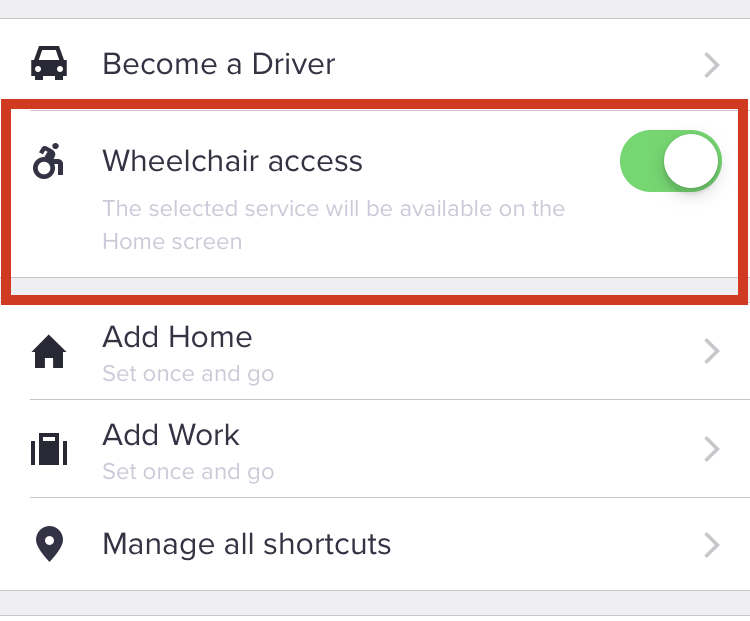
Upon closing and re-entering the app, I was given a prompt to call a number to request a wheelchair-accessible ride.
You must book many accessible vehicle rides at least 24 hours in advance. Lyft has a list of wheelchair accessible dispatches on their website. Consider looking into this well before your trip, as some companies have an enrollment process that can take weeks to complete.
Taxis and cabs
Various taxi companies have wheelchair-accessible vehicles available. Click here for a list of local wheelchair-accessible taxis.
Traveling by train with chronic pain
Taking a train is the most comfortable option for those living with chronic pain. Not only do you have more space to sit (because most train seats are larger than airline seats), but you also can stand up and stretch in the cabin during the ride. Book a front-facing seat if you’re prone to motion sickness, and pack an inflatable seat cushion or lumbar support pillow for comfort while sitting.
Train discounts
Amtrak generally offers a 10% discount if you have a disability and can provide documentation to support the request, like a letter from your doctor. Children with a disability are eligible an additional 10% off the already-discounted child’s fare. People with disabilities on the Downeaster train from Boston to Portland are eligible for a 50% discount. Booking is simple, as it’s just like booking a regular ticket, except you’ll need to select the Passenger With Disability (PWD) open from the “Discounts” drop-down menu.
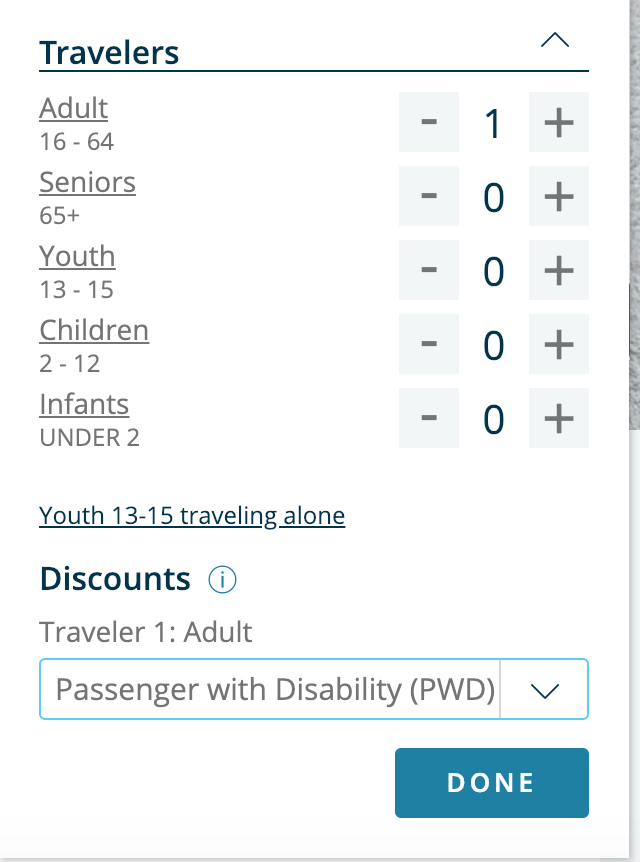
Assistance at various stations seems spotty. When purchasing my ticket from Boston to Portland, I got a message saying “in-station assistance is not available” at the stations I selected. The trains I chose were in the middle of the day on a Friday, so it seems odd to not have assistance available.
Use points for an Amtrak trip
Amtrak has a straightforward rewards program, with the cost of a ticket using points based on the cash price. There are no blackout dates or award fees.
One of the easiest ways to collect Amtrak points is with a Bank of America Amtrak credit card. The best option is the Bank of America Amtrak Guest Rewards® World Mastercard®, because for a limited time you can earn 40,000 bonus points after you make at least $2,500 in purchases within 90 days of account opening. You also get an annual complimentary companion coupon you can use for a ride.
Some people don’t like taking trains because of how long it takes. But taking a train can have advantages. It can be cheaper than flying, you don’t have to worry about going through security and the seating is more comfortable than most airlines or cars.
Traveling on a ship with chronic pain
Taking a cruise is a great experience for all ages, plus most ships are friendly and accommodating for those with disabilities. Other than the excursions off the boat, you won’t have to do much traveling once you’re on board, so you get to kick back and enjoy your vacation.
Before your trip:
- Make sure all the ports of departure are ADA compliant. All U.S. ports are required to be ADA compliant, but that isn’t guaranteed if your cruise makes stops in other countries
- Check with the cruise ship company to see if they need information ahead of time such as prescriptions and doctor’s notes. This would be a good time to make special arrangements for your arrival and departure, if needed
- If you have a wheelchair, make sure your cabin is wheelchair-accessible. Try to book a cabin close to an elevator to make it easier to get around. Look up excursions ahead of time to make special accommodations if necessary – many cruise ship lines have a ratings system for level of accessibility and difficulty
Many cruise ships have handicapped-accessible rooms available with roll-in showers, grab bars and other customization. While some activities can be physically straining, there’s always plenty to do even if you get exhausted, like a drink by the pool.
Booking a cruise with points
You can use your Chase Ultimate Rewards points or Citi ThankYou points to pay for a cruise. You can see your options on the Chase or Citi travel website, but you can’t book it online. Choose the cruise you want and call 855-234-2542 to book with Chase Ultimate Rewards points, or 800-842-6596 to book with Citi ThankYou points. Calling also gives you a chance to verify any room details, like proximity to activities and elevators and accessibility features, and to discuss other concerns.
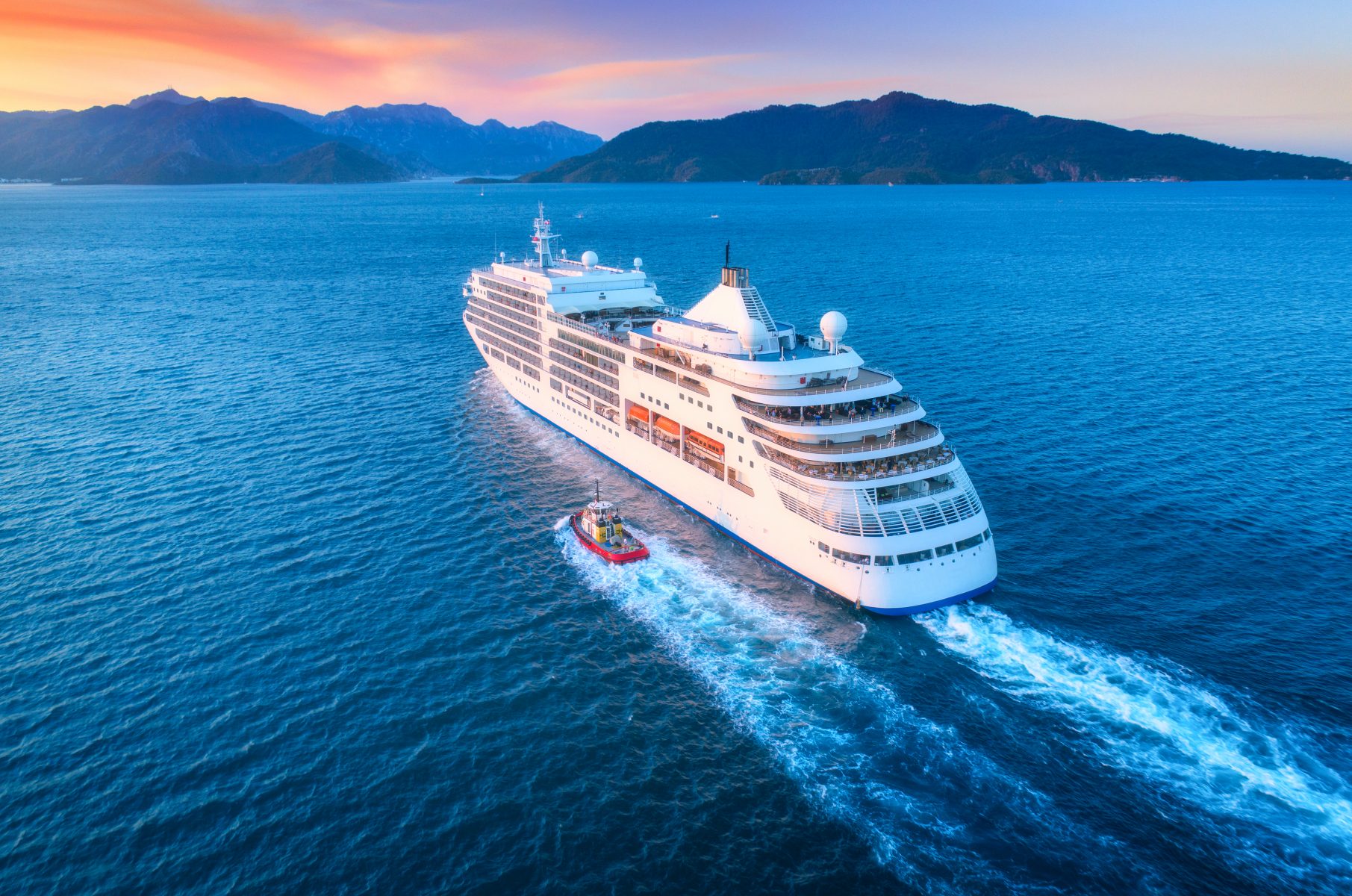
Each Chase Ultimate Rewards point is worth 1.25 cents for Chase Sapphire Preferred® Card cardholders, and 1.5 cents for folks with the Chase Sapphire Reserve®. Those with a Citi Premier® Card get 1.25 cents in value toward travel from each point.
Finding lodging when traveling with chronic pain
Choosing the right lodging when you live with chronic pain is important, because this will be your sanctuary after a long day of activities.
What to look for in a hotel
When booking your accommodations:
- Make a list of hotels in your price range that have rooms available for your needs. Once you’ve nailed down one or two potential hotels, call to confirm accommodations for disabilities
- Book a room with chairs or a couch, in case you can’t sleep well in the bed
- Request a room close to an elevator or on the first floor close to the lobby or an exit
- Ask about the room’s features, especially if you need one that is wheelchair-accessible and ADA compliant
- Find a hotel with a gym so you can stretch or walk on the treadmill before going out for the day. A sauna or hot tub would be a huge plus, because heat helps relieve pain
If you have medications that are supposed to be kept cold, make sure there’s a fridge in the room to store them.
Booking a wheelchair-accessible Airbnb
There’s an accessibility feature on Airbnb to help you find travel accommodations. To use it, open the Airbnb website or app and search your destination, dates and number of guests. When search results appear, click on filters and scroll down to “Accessibility.”
From there, you have ~20 filters you can select to accommodate your specific travel needs.

To be on the safe side, read the comments and try to book an Airbnb home where a previous guest requested the same accommodations you need. Many hosts will claim they are wheelchair-accessible without regard for specific needs, like grab-bars in the bathroom or a roll-in shower.
If you have any doubts about the amenities, go with a reputable hotel instead.
Other tips
If your pain renders you unable to move at times, consider getting travel insurance to protect your investment. In exchange for an up-front fee, you can cancel the trip in the event of illness and avoid financial loss. Usually, you can add this when you book your travel, or add it separately through a company of your choice.
Other ways to make yourself more comfortable:
- Book an extra day or two for resting, especially if you plan to travel a long distance
- Double-check you have the essentials, like medication, braces, muscle support, pain creams, and anything else you often turn to for relief
- Pack light – save your energy for exploring a new location, not lugging around heavy bags
- Write your doctor’s name and phone number, and your required medications, on a piece of sturdy paper and keep it in your pocket
- Consider a Medical Alert bracelet with this information so it’s always on your person
- Set an emergency contact on your phone so emergency responders can call if anything happens
I’ve always believed an ounce of prevention is worth a pound of cure. Taking precautions early can save you major headaches later.
And last but not least, a good attitude, while difficult to maintain when you’re in chronic pain, is the best way to keep your spirits up.
Bottom Line
Traveling with chronic pain can be challenging, but shouldn’t stop you from seeing the world. Taking time to prepare ahead of your trip will help you experience less pain and have more fun.
Whether you travel by plane, car, train or ship, reach out to confirm pertinent details with your travel provider. Look for discounts, ways to save time like TSA PreCheck, and places to make your journey more comfortable, like airport lounges, roomy Business Class seats and accessible lodging.
Finally, check out the best airline credit cards to earn miles and points for your next journey. Not only is it an easy way to save, but many perks can actually help make your travel smoother and more comfortable.
Do you have tips to share about traveling with chronic pain? Let us know in the comments.
Editorial Note: We're the Million Mile Secrets team. And we're proud of our content, opinions and analysis, and of our reader's comments. These haven’t been reviewed, approved or endorsed by any of the airlines, hotels, or credit card issuers which we often write about. And that’s just how we like it! :)






Join the Discussion!